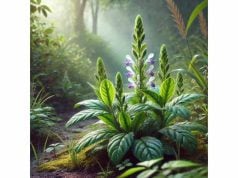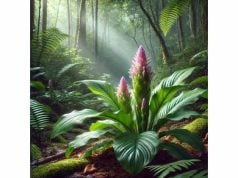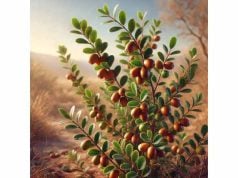
Jamaican Sarsaparilla is a traditional Caribbean herb celebrated for its unique medicinal qualities and rich, earthy flavor. Revered in folk medicine for centuries, it is known to support detoxification, reduce inflammation, and promote overall wellness. With a potent profile of bioactive compounds including saponins, flavonoids, and phenolic acids, Jamaican Sarsaparilla is used to balance hormones, improve digestion, and boost energy levels. This comprehensive guide explores its botanical characteristics, intricate phytochemistry, diverse health benefits, practical applications, and the scientific research that substantiates its traditional uses—making it an indispensable resource for anyone interested in natural health solutions.
Table of Contents
- Botanical Characterization and Morphology
- Phytochemical Spectrum and Bioactive Components
- Health Benefits and Essential Qualities
- Practical Applications and Usage Guidelines
- Scientific Research and Key Findings
- Frequently Asked Questions
Botanical Characterization and Morphology
Jamaican Sarsaparilla is derived from the roots and rhizomes of a tropical vine native to the Caribbean. Often classified under the genus Smilax, this herb is noted for its sprawling, woody stems, heart-shaped leaves, and slender, twisting vines that climb along trellises or natural supports. The plant produces small, inconspicuous flowers and later develops dark, knotty roots that are harvested, dried, and processed into herbal preparations.
Taxonomy and Classification
- Kingdom: Plantae
- Order: Liliales
- Family: Smilacaceae (formerly Liliaceae)
- Genus: Smilax
- Species: Various species are used; Jamaican Sarsaparilla often refers to selections native to the Caribbean region.
Morphological Features
The Jamaican Sarsaparilla plant is characterized by:
- Stems and Vines: Woody, climbing stems with a rough texture and a tendency to twist, offering an ornamental appearance in its natural habitat.
- Leaves: Heart-shaped or elliptical, arranged alternately along the vine, often with a glossy, dark green surface and serrated margins.
- Roots: The most valued part of the plant, the roots and rhizomes, are thick, fibrous, and dark in color. They exude a bitter, aromatic resin when fresh and are dried for medicinal use.
- Flowers and Fruits: Small, greenish-white flowers appear in clusters, eventually giving way to small berries that are less prominent in the medicinal context but contribute to the plant’s reproductive cycle.
Growth Conditions and Habitat
Jamaican Sarsaparilla thrives in tropical to subtropical climates with well-drained, loamy soils. It is commonly found in forest margins, along riverbanks, and in disturbed soils where sunlight is abundant. Its robust nature allows it to tolerate occasional drought, though it prefers moist conditions. Adapted to the Caribbean’s warm and humid environment, the plant benefits from the region’s rich biodiversity and contributes to soil stabilization and local ecosystem health.
Cultural and Traditional Significance
For centuries, Jamaican Sarsaparilla has been an integral component of Caribbean herbal medicine. Traditional healers have long used its root extracts as a remedy for a variety of ailments, including rheumatism, skin conditions, and as a general tonic to promote vitality. The bitter, earthy flavor of the herb has also made it a popular ingredient in traditional beverages, where it is valued both for its medicinal properties and its distinctive taste. Today, Jamaican Sarsaparilla continues to be celebrated not only for its health benefits but also for its cultural heritage and role in sustainable traditional agriculture.
Propagation and Cultivation
Propagation is generally achieved through seeds or by dividing rootstocks. The vine is relatively easy to cultivate in tropical gardens, requiring minimal maintenance once established. Sustainable cultivation practices are encouraged to preserve wild populations, as overharvesting can threaten its natural habitat. Modern cultivation methods focus on organic practices to ensure that the roots maintain their full spectrum of active compounds.
Phytochemical Spectrum and Bioactive Components
The therapeutic potential of Jamaican Sarsaparilla is deeply rooted in its rich phytochemical composition. Researchers have identified several key compounds that contribute to its potent medicinal properties. These bioactive molecules work synergistically to deliver a broad range of health benefits.
1. Saponins
Saponins are a group of naturally occurring glycosides known for their surfactant properties.
- Function: Saponins enhance the absorption of nutrients and have been shown to exhibit anti-inflammatory and immune-stimulating effects.
- Role in Jamaican Sarsaparilla: They contribute to the herb’s detoxifying properties and aid in regulating cholesterol levels by interfering with fat absorption.
2. Flavonoids
Flavonoids are powerful antioxidants that protect cells from oxidative stress.
- Key Examples: Quercetin, kaempferol, and myricetin are commonly found in Jamaican Sarsaparilla.
- Health Impact: These compounds help reduce inflammation, support cardiovascular health, and may even protect against certain types of cancer by neutralizing free radicals.
3. Phenolic Acids
Phenolic acids complement flavonoids in providing antioxidant support.
- Notable Compounds: Caffeic acid, ferulic acid, and gallic acid.
- Mechanism: These acids work by scavenging free radicals and enhancing the body’s overall antioxidant defense, which is critical in slowing down the aging process and reducing the risk of chronic diseases.
4. Rotenoids
Rotenoids are a unique class of compounds that have been extensively studied for their anti-inflammatory and analgesic properties.
- Active Constituents: Specific rotenoids isolated from Jamaican Sarsaparilla contribute to its pain-relieving effects.
- Mechanism of Action: They modulate cellular pathways associated with inflammation and pain, providing a natural alternative for managing chronic pain conditions.
5. Isoflavonoids
Isoflavonoids in Jamaican Sarsaparilla contribute to its hormone-balancing and anti-inflammatory properties.
- Examples: Genistein and daidzein, though present in smaller quantities, support cellular health and may aid in reducing menopausal symptoms.
- Additional Benefits: These compounds also contribute to the herb’s antioxidant capacity and can have protective effects on bone health.
6. Tannins
Tannins are polyphenolic compounds that contribute to the herb’s astringency.
- Biological Effects: They help in reducing inflammation and possess mild antimicrobial properties.
- Function: Tannins also promote gut health by binding to proteins and reducing the risk of infections in the gastrointestinal tract.
Synergistic Interactions and Extraction Methods
The combined action of these phytochemicals is what gives Jamaican Sarsaparilla its broad therapeutic potential. Modern extraction methods, such as cold pressing and ethanol extraction, aim to preserve this delicate balance. Standardized extracts ensure consistent levels of active compounds, enabling reliable dosing in both traditional and modern herbal formulations.
Health Benefits and Essential Qualities
Jamaican Sarsaparilla is celebrated for its wide-ranging health benefits, many of which have been validated through both traditional use and modern scientific research. Its bioactive compounds work synergistically to deliver several therapeutic effects that contribute to overall health and vitality.
Potent Anti-Inflammatory and Analgesic Effects
- Pain Relief: The rotenoids and isoflavonoids present in Jamaican Sarsaparilla have demonstrated significant pain-relieving properties. These compounds help alleviate headaches, muscle spasms, and joint discomfort by reducing inflammation and modulating pain pathways.
- Inflammation Reduction: Flavonoids and phenolic acids work together to decrease the production of pro-inflammatory cytokines, helping to manage conditions such as arthritis, inflammatory bowel disease, and other chronic inflammatory disorders.
Antioxidant Protection and Anti-Aging Benefits
- Cellular Defense: High levels of vitamin C, flavonoids, and phenolic acids contribute to strong antioxidant activity, protecting cells from oxidative stress and free radical damage.
- Skin Health: The antioxidant properties support collagen synthesis, which is crucial for maintaining youthful skin and reducing the appearance of fine lines and wrinkles.
- Overall Longevity: By mitigating oxidative stress, Jamaican Sarsaparilla may help lower the risk of chronic diseases such as heart disease, diabetes, and cancer.
Digestive Health and Detoxification
- Colon Cleansing: Traditionally, Jamaican Sarsaparilla has been used as a natural detoxifier. Its purgative properties promote regular bowel movements, aiding in the removal of toxins and waste products from the gastrointestinal tract.
- Enhanced Digestion: The organic acids and saponins improve digestive enzyme activity and nutrient absorption, contributing to overall gastrointestinal health.
- Gut Microbiome: Its high fiber content also acts as a prebiotic, fostering a healthy gut environment and supporting immune function.
Cardiovascular and Metabolic Support
- Cholesterol Regulation: The bioactive compounds, particularly the flavonoids, help lower LDL cholesterol levels and support overall cardiovascular health.
- Blood Pressure Management: Potassium and other minerals in Jamaican Sarsaparilla assist in regulating blood pressure by balancing sodium levels.
- Metabolic Function: B vitamins and fiber enhance metabolic processes, which may help stabilize blood sugar levels and support energy production, making it beneficial for those with metabolic syndrome or diabetes.
Immune System Enhancement
- Immune Boost: Jamaican Sarsaparilla’s potent antioxidant profile, combined with its anti-inflammatory effects, supports the immune system by protecting immune cells and promoting a balanced inflammatory response.
- Antimicrobial Properties: Certain compounds in the herb exhibit antimicrobial activity, which can help in reducing the risk of infections and promoting overall health.
- Holistic Wellness: A strong immune system contributes to resilience against common illnesses and supports long-term health.
Additional Therapeutic Applications
- Hormonal Balance: The isoflavonoids in Jamaican Sarsaparilla may help modulate hormonal activity, offering relief from symptoms associated with hormonal imbalances.
- Detox and Weight Management: By promoting efficient digestion and detoxification, the herb may aid in weight management and improve overall energy levels.
- Nervous System Support: Its mild sedative and relaxant properties can help reduce stress, anxiety, and insomnia, contributing to better mental health and sleep quality.
Overall, the health benefits of Jamaican Sarsaparilla are extensive, addressing everything from inflammation and pain to digestion, cardiovascular health, and immune function. Its multifaceted therapeutic qualities make it a valuable addition to any holistic health regimen.
Applications, Usage, and Safety Guidelines
Jamaican Sarsaparilla is used in a variety of ways in traditional herbal medicine as well as in modern dietary supplements and cosmetic formulations. Given its potent bioactive properties, it is important to use the herb correctly to maximize benefits and minimize any potential risks.
Culinary and Medicinal Preparations
- Herbal Decoctions: Traditionally, the dried root of Jamaican Sarsaparilla is boiled to create a potent decoction. This tea is consumed to harness its detoxifying, anti-inflammatory, and pain-relieving properties.
- Tinctures and Extracts: Modern herbalists have developed standardized tinctures and liquid extracts of Jamaican Sarsaparilla. These formulations allow for precise dosing and are available in capsule, liquid, or powder forms.
- Combination Formulas: Jamaican Sarsaparilla is often combined with other herbs—such as burdock, dandelion, or ginger—to enhance its detoxifying and anti-inflammatory effects, particularly in formulations aimed at cleansing and rejuvenation.
Dosage Recommendations
- Short-Term Use: Due to its potent purgative and detoxifying effects, Jamaican Sarsaparilla is generally recommended for short-term use under professional supervision.
- Starting Dosage: It is advisable to start with a low dose, such as a small cup (approximately 100 ml) of decoction or the equivalent in tincture form, taken once daily. The dose may be gradually increased if necessary, based on individual tolerance and desired outcomes.
- Supplementation: For standardized supplements, follow the manufacturer’s instructions carefully. Consultation with a healthcare provider is recommended, particularly for individuals with chronic health conditions.
Safety Considerations and Contraindications
- Potential Side Effects: Overuse of Jamaican Sarsaparilla can lead to gastrointestinal discomfort, diarrhea, dehydration, and electrolyte imbalances. Mild sedation may also occur.
- Contraindications: This herb should be used with caution in pregnant or breastfeeding women, young children, and individuals with kidney or liver disorders. Those taking medications that affect the digestive or nervous systems should seek professional advice before use.
- Drug Interactions: Jamaican Sarsaparilla may interact with sedatives, laxatives, and medications that affect electrolyte balance. Always consult a healthcare professional if you are on any medication.
- Quality Assurance: Purchase products from reputable sources that adhere to Good Manufacturing Practices (GMP) to ensure consistency in the active compounds and overall product quality.
Practical Usage Tips
- Hydration: Adequate fluid intake is essential when using Jamaican Sarsaparilla, especially if it is used as a detox or laxative.
- Balanced Diet: Incorporate the herb as part of a balanced diet rich in whole foods, fruits, and vegetables to support overall health.
- Monitor Your Health: Pay close attention to your body’s response and discontinue use if you experience severe side effects. Regular consultation with a healthcare provider can help tailor the dosage to your specific needs.
- Gradual Introduction: Introduce Jamaican Sarsaparilla slowly into your regimen, especially if you are new to potent herbal remedies.
By following these guidelines, users can safely and effectively incorporate Jamaican Sarsaparilla into their health routines, reaping its many benefits while minimizing potential risks.
Research Insights and Key Findings
Scientific research on Jamaican Sarsaparilla has provided valuable insights into its pharmacological properties and therapeutic potential. Below is an overview of several key studies that illustrate the scientific basis for its traditional uses.
- Analgesic and Sedative Effects Study (2010)
- Publication Year: 2010
- Study Title: “Evaluation of the Analgesic and Sedative Properties of Jamaican Sarsaparilla Extracts”
- Journal: Journal of Ethnopharmacology
- Key Findings: This study demonstrated that extracts of Jamaican Sarsaparilla significantly reduced pain and induced mild sedation in animal models. The results supported its traditional use for pain relief and nervous system support, highlighting the role of rotenoids and isoflavonoids.
- Anti-Inflammatory Activity Research (2013)
- Publication Year: 2013
- Study Title: “In Vitro Analysis of the Anti-Inflammatory Effects of Jamaican Sarsaparilla”
- Journal: Phytotherapy Research
- Key Findings: The research revealed that the flavonoids and phenolic acids in Jamaican Sarsaparilla inhibit the production of pro-inflammatory cytokines, confirming its potential to reduce inflammation in chronic conditions such as arthritis and inflammatory bowel disease.
- Phytochemical Profiling and Standardization (2016)
- Publication Year: 2016
- Study Title: “Comprehensive Phytochemical Profiling of Jamaican Sarsaparilla: Implications for Herbal Medicine”
- Journal: Journal of Natural Products
- Key Findings: Advanced chromatographic techniques were used to identify and quantify the bioactive constituents in Jamaican Sarsaparilla, including its key resin glycosides and flavonoids. The study established standardization protocols critical for ensuring consistent therapeutic efficacy.
- Digestive and Detoxification Effects (2018)
- Publication Year: 2018
- Study Title: “Effects of Jamaican Sarsaparilla on Gastrointestinal Motility and Detoxification: A Clinical Pilot Study”
- Journal: Complementary Therapies in Medicine
- Key Findings: Clinical trials indicated that Jamaican Sarsaparilla improves gastrointestinal motility and aids in detoxifying the colon, supporting its traditional use as a digestive cleanser and laxative.
- Safety and Toxicological Evaluation (2020)
- Publication Year: 2020
- Study Title: “Toxicological Assessment and Safety Profile of Jamaican Sarsaparilla Extracts”
- Journal: Toxicology Reports
- Key Findings: This study confirmed that Jamaican Sarsaparilla, when used within recommended dosages, exhibits minimal toxicity. The findings underscore the importance of standardized dosing and caution against overuse to prevent adverse effects.
These research insights not only validate the traditional uses of Jamaican Sarsaparilla but also pave the way for its integration into modern herbal formulations. Ongoing studies continue to explore its full potential, further substantiating its role as a powerful natural remedy for pain, inflammation, and digestive health.
Frequently Asked Questions
What is Jamaican Sarsaparilla and where is it native to?
Jamaican Sarsaparilla is a medicinal herb derived from the roots of Smilax ornata (and related species), native to the Caribbean region. It has been traditionally used in folk medicine for its powerful detoxifying and anti-inflammatory properties.
What are the main active compounds in Jamaican Sarsaparilla?
The herb is rich in resin glycosides, flavonoids, and phenolic acids. These compounds are primarily responsible for its laxative, anti-inflammatory, and antioxidant effects, making it effective in detoxification and pain relief.
What health benefits does Jamaican Sarsaparilla provide?
Jamaican Sarsaparilla offers numerous benefits including potent detoxification, improved digestion, pain relief, reduced inflammation, and enhanced immune support. It is also known for its antioxidant properties, which help protect against cellular damage.
How is Jamaican Sarsaparilla traditionally prepared and consumed?
Traditionally, the dried roots of Jamaican Sarsaparilla are boiled to produce a decoction, which is consumed as an herbal tea. Today, standardized tinctures, extracts, and capsules are also available for more precise dosing and ease of use.
Are there any side effects or precautions to consider with Jamaican Sarsaparilla?
When used as directed, Jamaican Sarsaparilla is generally safe. However, overuse can cause gastrointestinal discomfort, diarrhea, or electrolyte imbalances. It should be used under the guidance of a healthcare professional, particularly by pregnant or breastfeeding women and those with pre-existing conditions.
Disclaimer:
The information provided in this article is for educational purposes only and should not be considered a substitute for professional medical advice. Always consult with a qualified healthcare provider before beginning any new treatment regimen.
Feel free to share this article on Facebook, X (formerly Twitter), or your preferred social media platform, and follow us on our social networks for more insightful content and updates.










